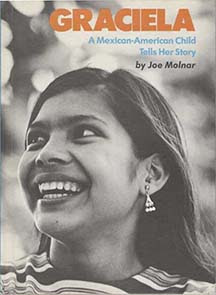Franklin Watts, 1972
grades 3-up
Mexican American
Graciela is the first of three “photo-and-tape”
books by Joe Molnar, an elementary-school teacher who later decided to devote
himself to photojournalism. Inspired by the civil rights movement, he created a
series of books that told the lives of minority children in their own words.
With portable tape recorder and camera, he traveled the country, meeting with
families, shooting photos and listening to what the children had to say about
their own lives.
Through a social
worker in Brownsville, Texas, Molnar met Graciela and her large, hardworking
Mexican-American family.*
The text of the book, he writes, is based on tape recordings of conversations
with Graciela. Most of the black-and-white photos, naturally lit, were not
posed; and what makes this book important is that the words are clearly
Graciela’s, with very little filtering by the author.
Twelve-year-old
Graciela, her parents and her seven brothers and two sisters are a close-knit
family who spend part of the year at home in Texas and part of the year in
Michigan, working as migrant agricultural workers. Initial photos show Graciela
hanging out with her family, working with her mother in the kitchen, and taking
care of and playing with the baby. It’s clear that this family enjoys being together.
But Graciela’s
family’s lives are difficult, sometimes harrowing. When her three-year-old
brother is hit by a motorcycle, “the hospital said we owed them two hundred
dollars and Abel would have to stay there until we paid. I got very upset when
I heard that and thought the hospital was ignorant and mean. But later, on the
telephone, the hospital said yes, we could take him home and we brought Abel
home the next day.”
At the beginning
of June, Graciela’s family heads north to Michigan, where they work the fields
to try to earn the little that will sustain them when they return to Texas. “School
isn’t over yet,” Graciela says, “but we have to go because we need the money.
My little brothers will be able to finish their classes in Michigan for the
month of June, but the rest of us won’t.”
When they get to
Michigan, the large family has to live in a two-room house with only a
two-burner stove and without an oven or even running water. Graciela
matter-of-factly describes the work:
My mother and me, we go out to one field.
My father, Eleazar, Irma, and María go to another field. They pick tomatoes,
watermelons, beans, cucumbers, squash, and pickles. Pickles are the worst,
because you have to be bending down all the time and get all wet, pickle plants
have a lot of water. My mother and me, we pick cauliflower. We get a big bunch
and separate them and put them in baskets.
We all start at seven in the morning and
work until noon. Then we go back to the house for lunch or sometimes eat in the
field. About one o’clock we start working again until four or five. We’re very
tired when we finish and come home, our wrists hurt and our hands. We get paid
a dollar fifty an hour.
While the
townspeople in Michigan are more-or-less friendly to them, Graciela says, back
in Texas her family has to contend with out-and-out racism at school,
especially from teachers. And, opposite a photo of Graciela somberly looking on
while her mother is talking on the phone, she describes her family’s financial
worries:
Sometimes my mother and
father worry a lot. They worry about sending us to school. They want very much
for us to finish school and not to have to take us out just so we can work.
They try their best to give us clothes and dress us up real good so we can go
to school neat and proud. They worry about feeding our family too. And getting
another bed so my little brother David doesn’t have to sleep on a mattress on
the floor. So they worry about money a lot. Right now we have enough to pay our
bills. We are paying off the house, and in two more years, it will belong to
us. And we are paying off our truck, we’re almost through with that and it’s a
big bill too, about ninety-five dollars a month. Our biggest worry right now is
how to pay the hospital for Abel. But we’ll be okay. We’ll manage.
The photos and
text in the rest of the book show Graciela and her sisters and brothers playing
“chase and hide-and-seek and a lot of games that we think up ourselves,”
dancing, and going to a carnival in Brownsville, a big town just across the
border from Mexico. And on the last page, a smiling, almost laughing, Graciela
is literally framed by her parents. “Sometimes I wish I was already in high
school or I wish I was already a nurse and working,” she says. “Then maybe I
could have a piano. I would study and learn how to play it real good. I would
play happy music. Music like it would make me feel everything is okay,
everything is going to be all right.”
For young
readers who are agricultural workers, Graciela
is a treasure. For young readers who cannot imagine what material poverty is
like or how their food arrives at the supermarket, Graciela can be an education in itself. In any event, I’d like to
see Graciela together with other excellent
picture books about the struggles of agricultural workers, such as Carmen
Bernier-Grand’s César: ¡Sí, Se puede!
Yes, We Can!, Kathleen Krull’s Harvesting
Hope: The Story of Cesar Chavez, and Sarah Warren’s Dolores Huerta: A Hero to Migrant Workers.
Although Graciela is an older out-of-print book,
it is available and highly recommended.
—Beverly Slapin
(published 7/25/15)
*Joe Molnar, telephone interview with Julia L.
Mickenberg, May 29, 2006. In Julia L. Mickenberg and Philip Nel, Tales for Little Rebels: A Collection of
Radical Children’s Literature. NYU Press, 2008.





